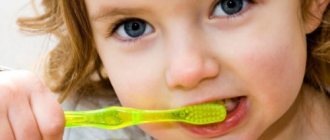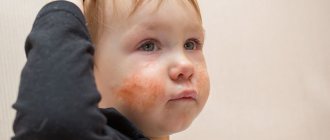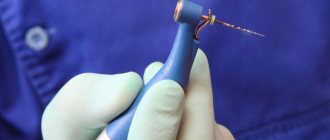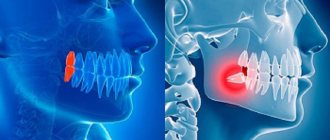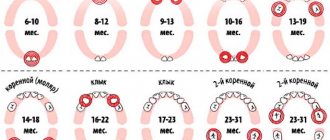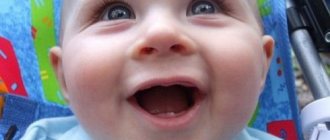The formation of teeth is a complex step-by-step process that begins in the first weeks of intrauterine life. Thus, by the time of birth, the baby has the rudiments of 20 primary and 16 permanent teeth inside each jaw. But, like all stages of development, teething in children under one year and older occurs differently. Some endure this period relatively calmly, others are capricious and sleep poorly. Why this happens and how to understand that the baby is cutting teeth, we will tell you further.
Timing of teething in children
On average, the first teeth in healthy children appear at 5–6 months. But sometimes it happens that someone has a white bump visible at 4 months, and someone smiles with a toothless mouth even at 8-12 months. And this is not a deviation from the norm. According to studies by a number of authors, the timing differs depending on the region of residence, race, and gender of the child. For example, children in the southern regions develop teeth a little earlier than those in the north. The formation of temporary teeth is also influenced by the following factors:
- heredity;
- maternal toxicosis in the second and third trimester of pregnancy;
- prematurity;
- artificial feeding;
- quality of drinking water;
- hypothyroidism and other endocrine pathologies;
- infectious diseases;
- weakened immunity;
- rickets.
It is impossible to speed up the timing and influence the sequence of teething in children. The only thing parents can do at this time is to alleviate the baby’s condition if he is restless and in pain (more on this below).
Eruption of baby teeth. Symptoms.
Teething in children is not a disease, but a natural physiological process. It can be accompanied by different symptoms in different children.
Typical symptoms of teething:
- Swollen gums and increased salivation are a characteristic sign of the onset of teething. These phenomena can be observed 3-6 weeks before the appearance of the first tooth. Drooling is due to irritation of the nerve endings in the mouth. Redness, swelling and inflammation of the gums are caused by increased blood supply to the areas above the growing teeth. These manifestations cannot be avoided, but their intensity can be reduced. The drug Dantinorm Baby reduces swelling and soreness of the gums, relieves inflammation.
- The child makes intense chewing movements with his gums - this is how he tries to get rid of the obsessive itching. To help your baby relieve discomfort, offer him a special chewing ring. You can use any dense rubber toy if you are sure that the material from which it is made is safe. The item should not have sharp edges or crumble into small pieces. You can pre-cool the ring or toy in the refrigerator.
- A wet cough in a baby during this period may be caused by an increase in the amount of saliva. Cough associated with teething does not require treatment. However, if he becomes intrusive, wheezing and profuse sputum are observed, it is worth showing the baby to the pediatrician.
- A child’s runny nose appears due to the activation of the glands of the nasal cavity. Normal nasal discharge in this case should be watery and clear. You can help your baby by promptly clearing his nose of secretions.
- The increase in temperature during teething is short-term and transient. Low-grade fever (37-38 °C) should not be “brought down” with narrowly targeted medications. To reduce temperatures above 38 °C, it is recommended to use paracetamol-based medications, drink plenty of fluids, and wet wipes. A high temperature for more than two days is a reason to urgently consult a doctor!
- Digestive disorders and loss of appetite are caused by the restless state of the child and a change in the usual diet. Diarrhea can be caused by excessive swallowing of saliva. In this case, the stool should not be too frequent, watery, without a pronounced unpleasant odor. If bloody or mucous streaks appear, stools become more frequent and the temperature rises, you need to show your baby to a pediatrician to rule out infection. One of the accompanying symptoms may be diaper rash in the baby's perineum, the reason for this is excessive salivation during teething, and as a result, more acidic and fermented stools, affecting the delicate skin of the baby's bottom, resulting in a rash and irritation. By the way, a rash from excessive drooling can also appear around the baby’s mouth.
- Older children may complain of nagging pain in the ears, while younger children may complain of pulling or scratching their ears.
- Behavioral disturbances when feeding and falling asleep - the child becomes more restless and irritable
Dantinorm Baby helps to quickly relieve all the main symptoms of teething in a child. It contains plant components that help reduce inflammation and soreness of the gums and normalize digestion.
The drug is available in a convenient form, is easy to use and has virtually no contraindications. In any case, do not hesitate to show your child to the pediatrician once again, so as not to confuse the symptoms of teething with a more serious cause of the baby’s illness.
The order of eruption of baby teeth:
Timing and sequence of teething in children. One of the important milestones in the development of a baby is the eruption of the first teeth, which begins at the age of about 3 months and lasts until 2.5-3 years. Normally, a baby (i.e., up to one year) should erupt eight teeth in the following order.
- The two lower incisors usually erupt first. This occurs between 3 and 9 months.
- Next, they are joined by the upper incisors with a one-month delay, i.e., between 7 and 10 months.
- At the age of 9 to 12 months, first the lateral incisors on the upper jaw and then the lateral (second) incisors on the lower jaw should erupt in your baby’s mouth. Thus, a one-year-old child normally moves from the status of an infant to a toddler with eight incisors . After a year, teething occurs almost continuously in a child.
- In the interval of 12-18 months, the first upper molars (the so-called “first molars”) erupt, and 13-19 months – the first molars on the lower jaw.
- At 16-20 and 17-22 months, the eruption of canines should be expected on the upper and lower jaws, respectively.
- At 20-23 and 24-26 months, the child’s second molars erupt, first on the lower and then on the upper jaw (“second molars”). However, due to hereditary factors, as well as the child’s nutritional characteristics, these dates can significantly degree to change. Therefore, there is no need to panic with minor deviations. If in doubt, you should consult a specialist.
Subsequence
The order in which teeth appear may vary, which is rare and is not considered pathological. For some boys and girls, the upper incisors appear first, rather than the lower incisors as usual. But basically the sequence of teething in children is as follows (teeth appear in pairs):
- lower central incisors;
- upper central incisors;
- upper lateral incisors;
- lower lateral incisors;
- first upper molars (molars);
- first lower molars;
- upper canines;
- lower canines;
- second lower molars;
- second upper molars.
By the age of 2.5–3 years, the child has a full set of baby teeth: 10 on each jaw. After about 4–6 years, the roots begin to dissolve, the teeth lose support and fall out in the same order in which they erupted.
As the jaw and facial bones grow, spaces form between the primary teeth. This provides space for permanent, larger teeth to emerge, which erupt from 5 to 15 years of age.
Can a baby cut teeth at such an early age?
The average time for teeth to appear in infants is 6–8 months. The first to grow are the two lower central incisors, which usually erupt one after the other. But you should understand that the time frame is not limited. Sometimes the process may take some time. There are cases when the first incisors appear earlier. Therefore, when asked whether teeth can be cut at two months, experts answer in the affirmative. A deviation of the time frame by several months in both directions is considered normal. Only if a one-year-old child does not have a single tooth should you consult a doctor.
Each organism is individual, so some babies already have their first tooth at 2–3 months. The process is determined not only by genetics, but also by a number of other factors:
- climatic conditions;
- maternal nutrition;
- features of the course of pregnancy;
- disruptions of the endocrine system - sometimes the early appearance of teeth may indicate its abnormalities.
If during pregnancy the mother took multivitamins or additional mineral complexes containing vitamins D and C, then the timing of teething may accelerate. A woman’s consumption of fermented milk products in large quantities also contributes to this.
Symptoms
Usually, no serious problems arise during teething, but local (in rare cases systemic) disturbances are present. These include:
- swelling and soreness of the gums;
- profuse drooling;
- irritability;
- restless sleep;
- lethargy;
- the baby's need for biting and chewing;
- poor appetite.
Loose stools, low-grade fever and runny nose are less common than the above symptoms.
Important! If the body temperature rises above 38 degrees, convulsions, difficulty breathing, you need to show the baby to a doctor and call an ambulance. This may indicate a viral infectious disease and is not a sign of teething.
Some parents wonder why this process occurs differently in babies. For example, in some teething occurs with fever, in others it does not. It is noted that, among other factors, this is also influenced by the child’s constitutional type. In children of the allergic type, this period may be accompanied by increased moodiness, atopic dermatitis, and ARVI is often associated. Infants with asthenic syndrome sleep poorly, refuse to eat, and cry for a long time due to severe pain.
Main signs and symptoms
Many parents are in a hurry to find out how their children are teething, especially those who are faced with this phenomenon for the first time. Rarely does such a process go unnoticed; most often it manifests itself with characteristic symptoms.
Experts call the following main symptoms that a child is teething:
- worsening sleep;
- increased moodiness and tearfulness of the baby;
- Bad mood;
- swollen and sore gums;
- loss of appetite, sometimes even leading to refusal of food;
- increased salivation;
- the child puts everything into his mouth, so he tries to relieve the pain;
- the formation of various redness and rashes around the mouth caused by skin contact with saliva.
In addition to the main signs indicating the appearance of teeth in children, accompanying symptoms can also be traced. Due to the increased function of the salivary glands, the following may be observed:
- runny nose;
- hoarseness of voice;
- cough without sputum production;
- indigestion in the form of diarrhea.
Often, as a child teethes, the body temperature rises. Usually it stays at around 37.5 ̊C, but it can rise to 39 ̊C.
The most severe pain is accompanied by the eruption of fangs. They have very sharp edges that cut through the gums and cause severe pain. The appearance of the upper “eye teeth” is especially painful, as they are closely connected to the facial nerve.
The approximate timing of eruption of milk jugs is presented in the table below.
| Tooth name | Baby's age |
| Central incisors | Below - at 6-9 months, above - 7-10 |
| Lateral incisors | On the upper gum – 9-11 months, on the lower gum – 11-14 |
| First molars | In the bottom row - in a year and a half, in the upper – 13-20 months |
| Fangs | In the lower dentition - 16-22 months, in the upper dentition - 17-23 |
| Second molars | Below - at 20-26, above - at 26-33 |
Please remember that this is just a rough guide to teething timing. Later dates are also acceptable, but not later than 6 months.
How to help your baby teething
To eliminate unpleasant symptoms and make the child feel better, parents are advised to:
- Buy teethers made of silicone or special soft plastic filled with water. These devices are cooled to a comfortable temperature (not frozen) and given to the baby. Cold reduces pain in the gums and relieves swelling.
- Massage your gums. To do this, an adult needs to wrap his finger in a clean gauze swab, moisten it in cool boiled water and lightly massage the inflamed area.
- Give ibuprofen or paracetamol if the child is very restless or has a high fever. The dosage is prescribed by the doctor.
Important! During teething, babies put everything in their mouth, which can cause a secondary infection. Therefore, parents need to carefully monitor oral hygiene, regularly wipe their face with a clean towel, and gently blot saliva.
As for special gels for gums, you need to be careful and not use them too often, as some components can cause an allergic reaction.
Teething symptoms
There is an opinion that the appearance of the first teeth is accompanied by the development of a whole complex of pathological processes (fever, the appearance of a rash, abnormal stool, vomiting, convulsions, etc.). In fact, the formation of a temporary bite is a natural process that is not characterized by the symptoms described above. Pathologies detected during the teething period are most often manifestations of infectious diseases or a consequence of changes in diet.
In particular, factors that can lead to the appearance of unpleasant symptoms include:
- introduction of artificial complementary foods;
- hypovitaminosis;
- acute viral infections;
- stomatitis;
- tonsillitis;
- runny nose;
- otitis;
- vaccination, etc.
The true symptoms of teething are:
- hyperemia and gradual swelling of the gums;
- the appearance of a small bluish hematoma on the gum tissue;
- slight bleeding from the gums;
- wet cough;
- mild itching caused by mechanical irritation of sensitive nerve fibers in the gum tissue;
- increased salivation;
- various somnological disorders;
- sharp deterioration in appetite;
- tearfulness, capriciousness.
Caring for baby teeth
You need to take care of your teeth immediately after teething. Moms do it first. For adults, special finger brushes have been created that are convenient for cleaning teeth from plaque, but so far without toothpaste. When the baby learns to rinse his mouth and spit, they move on to brushing with children's toothpaste without fluoride (this can be done earlier if the tube indicates that the toothpaste is from 0 years). So, gradually, the child will form a useful habit of caring for the oral cavity.
Another important reason for caring for teeth from infancy is that it affects the formation of permanent teeth and bite. For example, caries of a temporary tooth can transfer to the germ of a permanent one. And early loss (before 5 years) of a baby tooth will lead to uneven dentition in the future. If the molar does not begin to grow in time, the adjacent baby teeth will move and fill the resulting space.
When to see a doctor
When a child is teething, his immune system is weakened. Symptoms that parents attribute to teething may be hiding a viral or bacterial infection. Don't wait for it to go away on its own and see a doctor if:
- the child has a temperature above 38.5℃;
- he became lethargic and drowsy;
- refuses food;
- Vomiting and diarrhea began.
So:
- When teeth are being cut, the baby’s gums may be painful and swollen; this is a normal phenomenon; otherwise the tooth cannot pass through the tissues of the jaw and gums;
- When the gums erupt, they look swollen, reddened, then they turn white, and a hole forms in the place of the future tooth;
- You should not use a gel to relieve pain in your baby’s gums unless absolutely necessary; if the pain bothers the child greatly, then choose gels without anesthetics or combination drugs;
- If, against the background of teething, the child has a high fever, he is very restless or, on the contrary, lethargic, refuses to eat, if vomiting or diarrhea begins, consult a doctor.
(0 ratings; article rating 0)
Share Share Share
